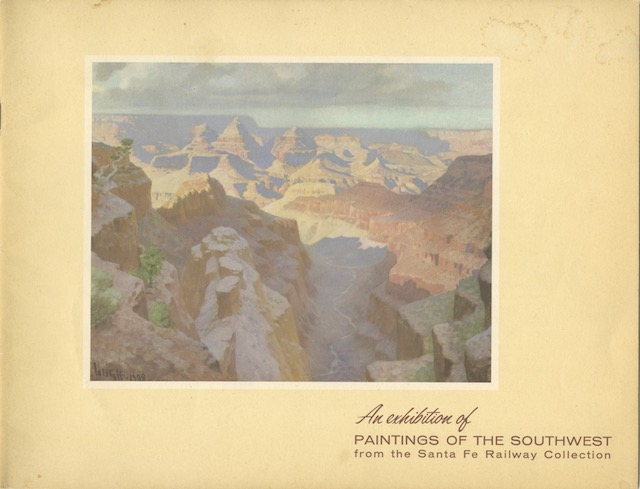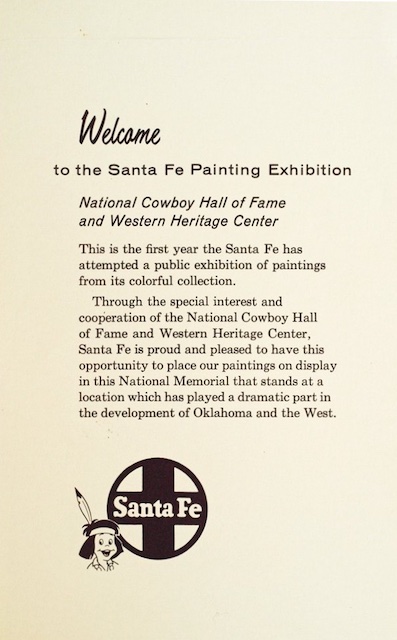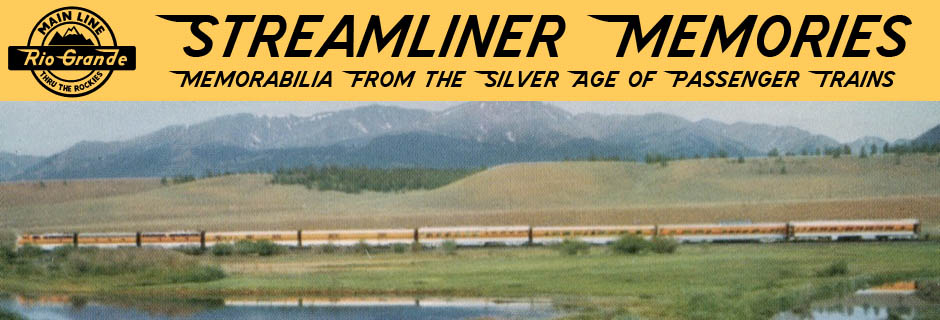In 1892, the Santa Fe Railway agreed to pay the expenses of Thomas Moran, famed painter of Yellowstone, to the Grand Canyon provided the railway would be allowed to choose a painting to use in its advertising. This began the Santa Fe Railway art collection.

Click image to download a 6.5-MB PDF of this 28-page booklet.
Until 1966, members of the public were familiar with only those parts of the collection that the railway used on its calendars, menus, and advertising. However, in that year the railway decided to put a portion of the collection on a public tour. This may have been an effort to promote its passenger trains or merely a way to establish good will in communities where most people were no longer riding trains.
Among the museums that the exhibit toured to were the Phoenix Art Museum, the University of Texas at El Paso, and the Cowboy Hall of Fame and Western Heritage Center in Oklahoma City. This booklet was distributed at all of the venues with a card inserted, such as the one below, thanking each museum for hosting the exhibit. My copy of the booklet didn’t come with an insert but I found an image of this one on line.

Click image for a larger view.
The booklet includes black-and-white (actually brown-and-yellow) reproductions of the 30 paintings in the exhibit (which were only about 5 percent the railway’s collection) along with brief biographical information about each of the 22 painters (since 8 had two paintings in the exhibit). For those who are interested, color images of 80 paintings in the Santa Fe collection, including many of the ones in the 1966 exhibit, can be found in the 1991 book, Visions & Visionaries, used copies of which can be purchased for as little as $5 from on-line booksellers or on ebay.
Today, most of the Santa Fe collection, along with paintings collected by the Great Northern and other BNSF progenitors, is at BNSF headquarters in Fort Worth. The railway opens its doors to the public once in awhile, but Fort Worth is a long way for many people to go.
Some 30 years ago, I noticed that I look a little like James J. Hill and that a speech he gave on conservation issues in 1910 mirrored my own beliefs on the subject and illustrated that the debate really hadn’t advanced much in the last century. So I asked someone to make me a 1910 suit and memorized his speech (or, at least, an edited version of it — people were pretty long-winded in 1910).
I gave this speech many times including, at some point, at a meeting in Irving, Texas. While there, I drove over to Fort Worth to drop in on the BNSF headquarters. I was impressed to see James J. Hill’s own desk in the building’s lobby.
I asked someone at the front desk if I could meet the company historian, not even knowing if it had a historian. It turns out that it did, but it wouldn’t for much longer as he was retiring soon. (The company may have hired another historian since then but at the time it wasn’t planning to immediately replace him.) He gave me a tour of the headquarters, including the large operations center from which all trains on the railway were directed.
I was more interested, however, in the art, ranging from, as I recall, a wall-sized Thomas Moran painting of Yellowstone Falls in the president’s office to numerous Winold Reiss paintings scattered throughout the building. If you ever get a chance to see the company collection of around 700 paintings and hundreds of other artifacts, I highly recommend it.
